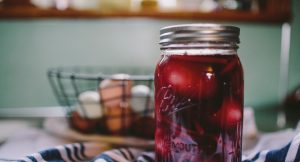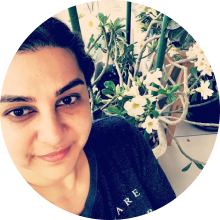The preservation of a Parsi upbringing
01 April 2017They stood like sentinels in a cage in the kitchen. Various sized bottles holding marriages of sweet, briny, smooth, nutty, fruity, garlic, vegetable, prawn and any other flavour imaginable. Tall and sleek, squat with a dimpled round surface, boxy but spacious, the jars in my granny’s larder. So many pickles in so many bottles holding so much love.
My grandmother was a Parsi. Parsis are the perfect mix of good humour, eccentric behaviour and delicious food culture. Their unique situation – ancestral roots in Iran with a strong influence of Gujarati gastronomy and language –makes Parsi food an interesting epicurean experience unlike any other type of Indian cuisine. Mostly unpronounceable dishes are cooked with intense yet surprising flavour combinations to produce the most unforgettable type of food. Each year of my youth I’d look forward to a Parsi wedding or confirmation ceremony in extended family or friends, since these produced food feasts unparalleled by other Indian events. Whether it was fresh pomfret slathered in tangy coriander chutney wrapped in a banana leaf (paathra ni macchi) or chunks of chicken dragged through eggy batter and deep fried (chicken farcha) or the delicate wobble of creamy caramel (lagan nu custard), Parsi food remains my favourite type of food.
But the shining stars of my grandmother’s kitchen were her pickles. I remember walking through the labyrinthine spreads of raw mangoes, limes and chillies, drying out in the baking April sun on her home’s large attached terrace, the soles of my feet blistering their protest, but my mouth watering its consent. I remember huge empty vats, their insides hollow, awaiting the arrival of the dry goods. The limes, lemons, mangoes, ginger, garlic, chillies, carrots, onions, capers and whatnot would be chopped, shredded, julienned, sliced (cut in a myriadways) and fistfuls made their way into those vats, where they were smothered in weird and wonderful spices, preserved with herbs bought fresh at the local market. Different combinations produced different flavours. Only she knew the ratio of the vegetables to the oil, the sugar to the cayenne pepper, the tamarind to the mustard seeds (popped in searing hot oil to release their pungency). Only she knew what temperature to preserve the lemon rind until it was ready to be squashed under the weight of a ton of jaggery. And only she knew each family member’s favourite type of pickle.

Mine was the murabba. The Parsi murabbais a tangy amalgam of thinly stripped raw mango marinated over many weeks then left to drown in jaggery syrup, cayenne pepper, salt, tamarind juice and some other secret stuff. The finished product was a firm yet fleshy pickle, best scooped into fresh, hot chappatis or slowly licked with one guilty index finger as it waited on a plate for the ubiquitous dal/chawal. Regular Parsi dal is usually cooked with lots of garlic and tempered with cumin. Other types of dals are the dhansak and the masala dal. The former is infamous (but has morbid origins as it was originally served at memorials), the latter is a thick, spicy version of the regular.
Murabba (gentrified from the Arabic Ǯmirabbaǯ– for jam) is an idea originating in the Caucasus (present day Armenia, Georgia and Azerbaijan). Merchants who travelled to India from these lands (once a large part of ancient Persia) adopted the local aam, or mango, into their murabba. The locals kind of liked the taste –hey, a major active ingredient is sugar! – and made it their own by hefting it with spice from chillies and sourness from lime juice. Gujaratis like their food balanced with its own share of sweetness and their pickling creations enjoy their fair share of sweetness, achieved by adding sugar in its various stages of processing – from nubby nutty jaggery to fine white powder. Gujaratis murrabo-fy all sorts of vegetables and fruits – gourds, gooseberries (aamla), apples, lime peels… throwing in peanuts and chironji for good measure. My granny kept it real by making it only with raw mango and her set of ingredients – too complex a challenge to quantify.
Recently my parents visited me in Dubai. My mum brought along a car battery sized amount of store bought murabba which sat in my fridge for all of three weeks, being licked clean to a point where washing its container was perhaps unnecessary. No one can replicate my grandmother’s murabba but having no choice, anything reminding me of it, and her, is lovingly welcome.
Here is a small recipe of a fresh tomato pickle I make at home, nothing even close in taste to a murabba, but I enjoy it with samosas or bhajias in the evening. I hope you do too.
Ingredients:
4 medium fresh tomatoes, chopped, deseeded and skins removed
a teaspoon of cumin seeds
a teaspoon of black mustard seeds
one large green chilli slit length-wise
pinch of asafetida (hing)
half teaspoon of grated ginger
8-10 dry (or 5-6 fresh) whole curry leaves
one teaspoon refined sugar
half teaspoon salt
1-2 tablespoons lime juice
2 tablespoons groundnut oil
Method:
Heat the oil in a small saucepan until very hot, add the cumin and mustard seeds, wait for them to sizzle and pop. Add the green chilli and asafetida and stir. Reduce the heat to medium. Add the ginger and curry leaves, leave to emulsify, about one minute. Make sure not to burn the curry leaves.
Now add the fresh tomatoes and allow to cook for ten minutes on low heat until a thick paste forms, stir occasionally. Add the sugar, salt and lime juice toward the end of cooking time. Adjust to taste. If you like it more spicy, add one more green chilli at the time of tempering.
Allow to cool completely and use after a day. This fresh pickle can be stored for up to a week in the refrigerator.
About the author:
Peri Desai reinvents herself every couple of years. In previous versions she has been a print, radio and photo journalist, a communications expert, a media manager, and a published poet. She has worked for The Times of India, the BBC World Service and the United Nations. Her stints have seen her live in Mumbai, London, New York and Reykjavik.
She continues to be a mother, a daughter, a sister, a writer and a lover of house plants and pets. When she isn’t traipsing off to different corners of the globe,you’ll find her in Dubai, home for the last few years. But that may change at amoment’s notice.
 0 comments
0 comments

